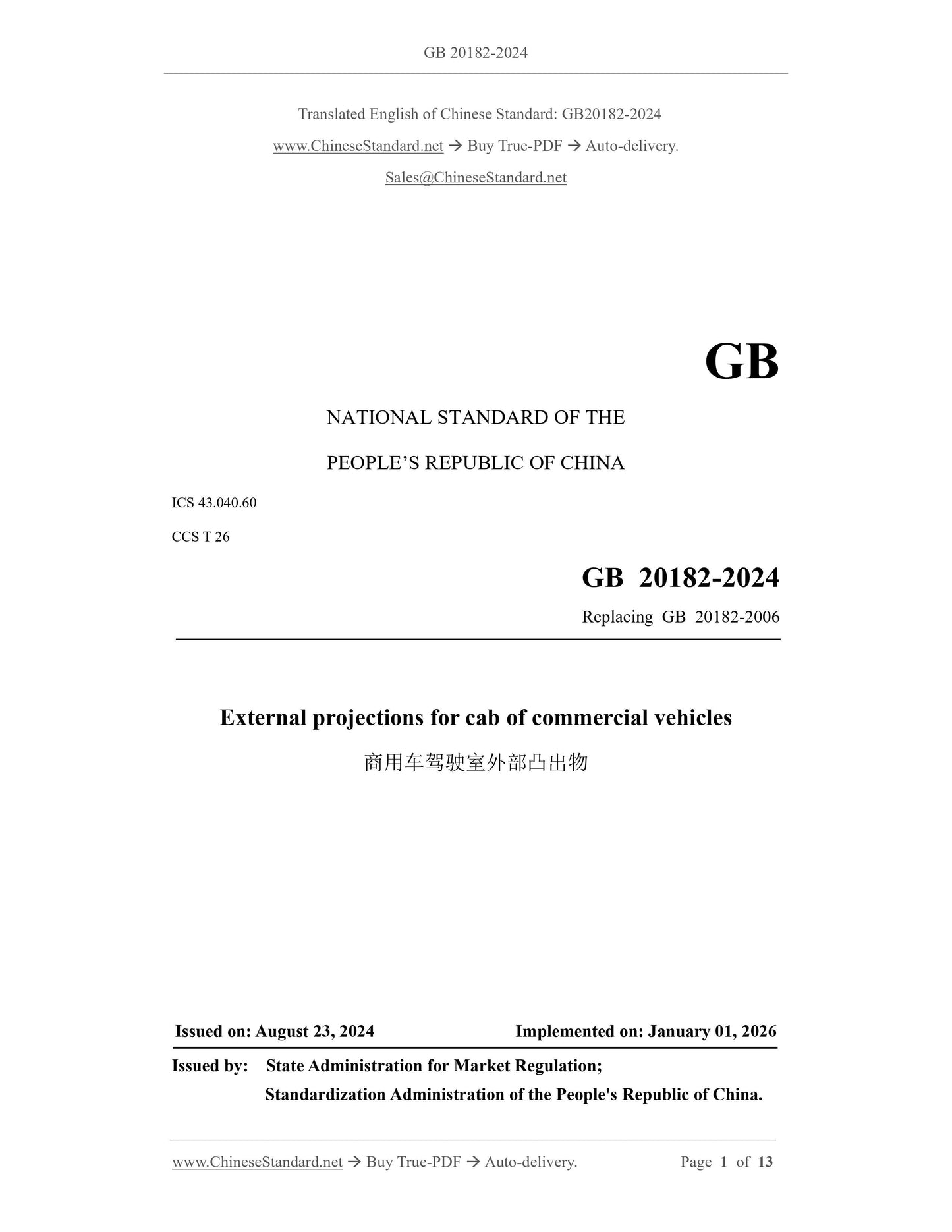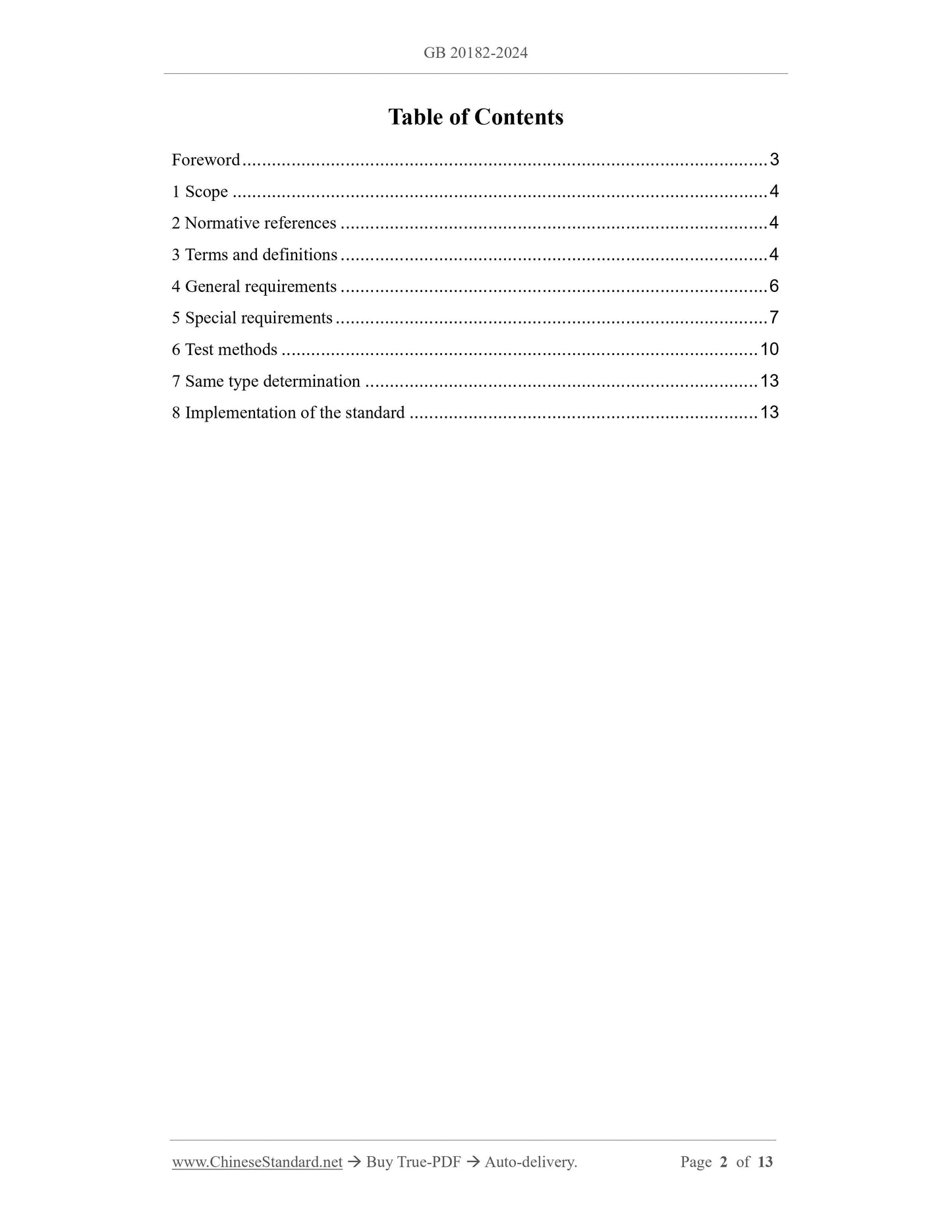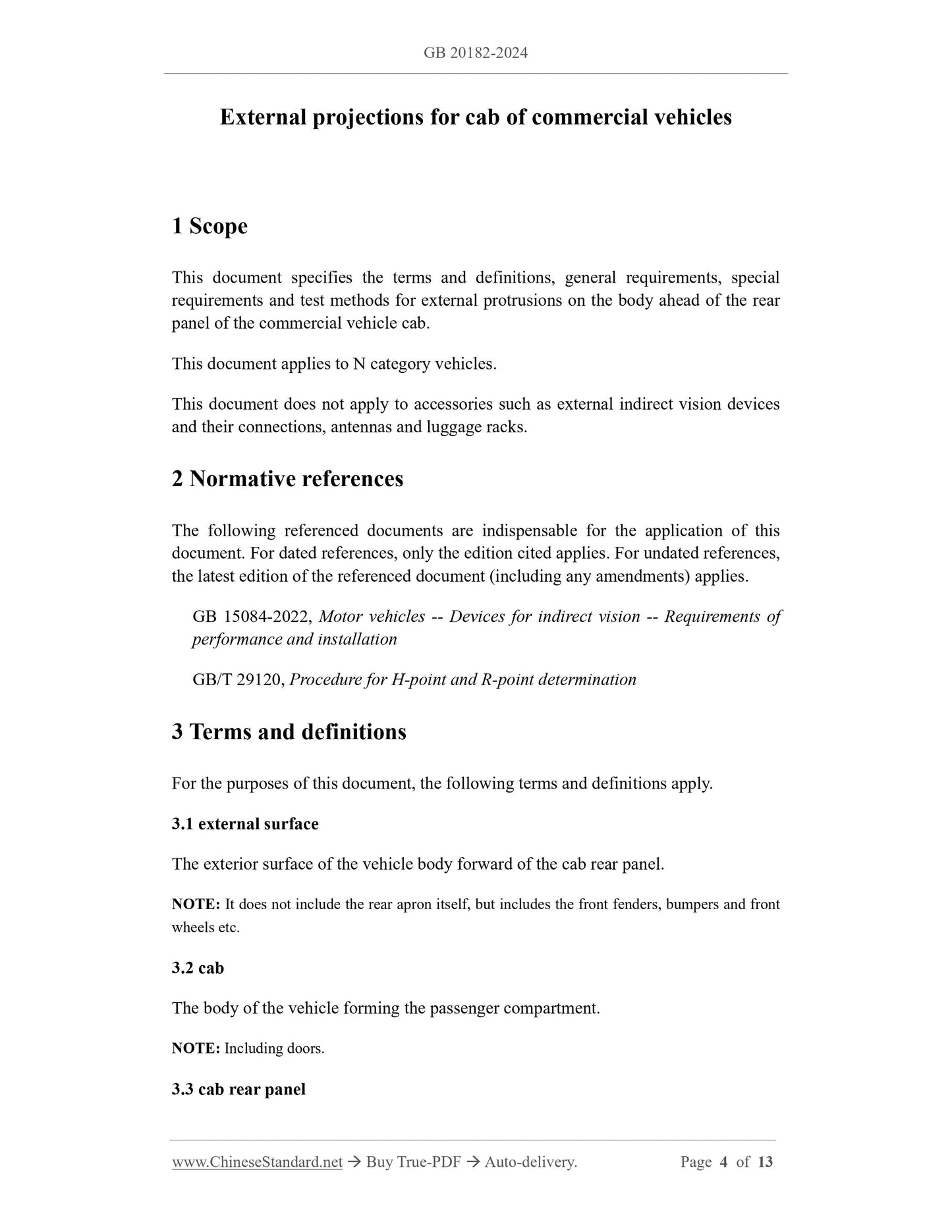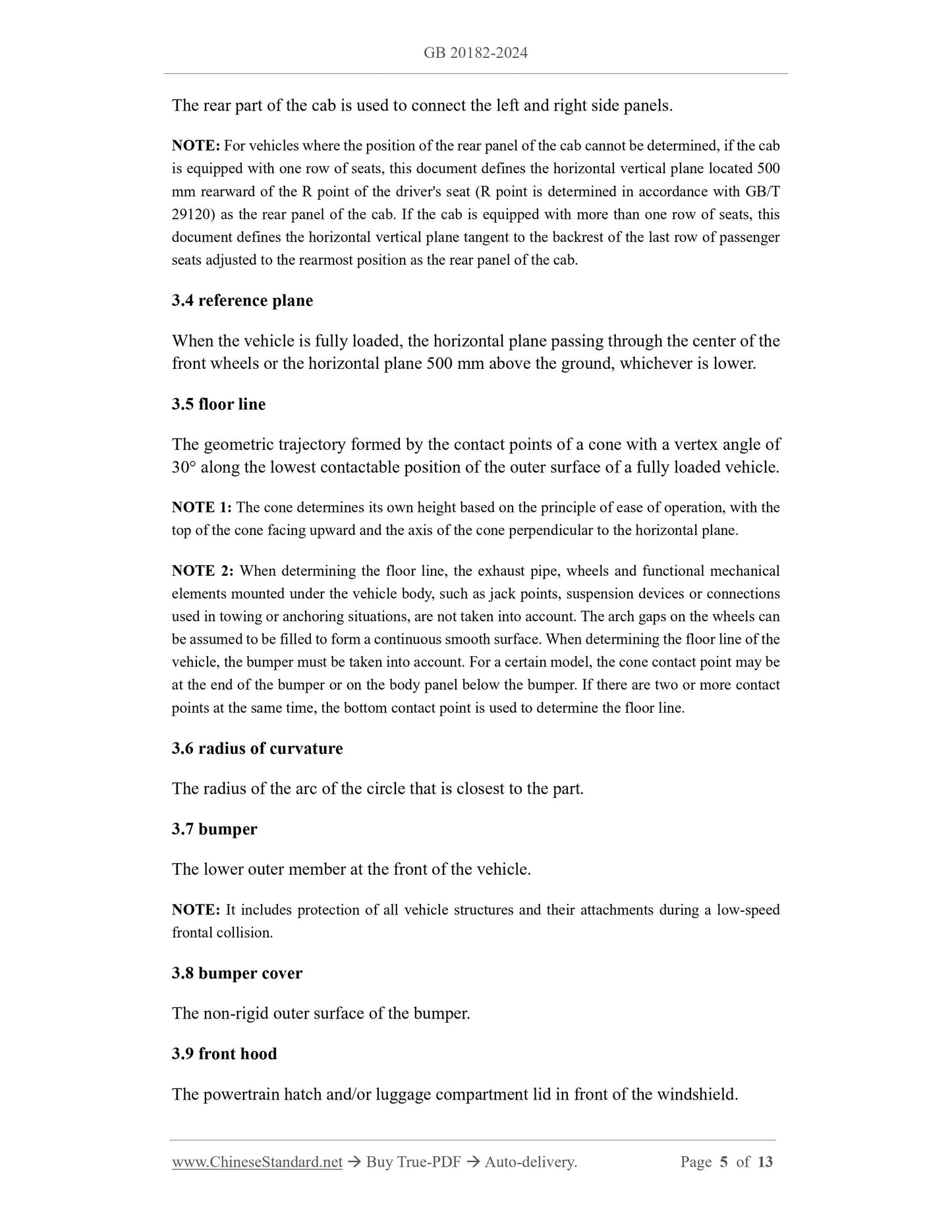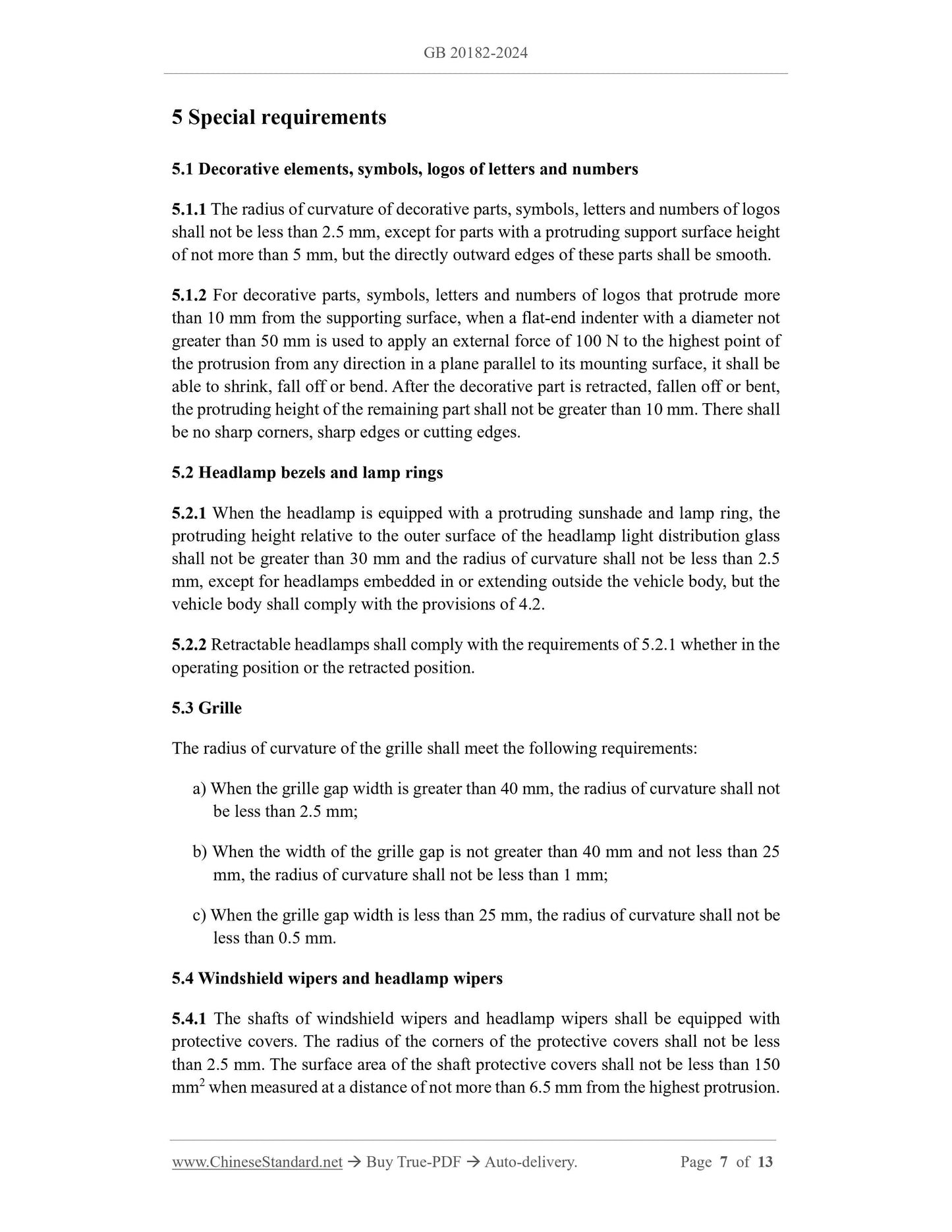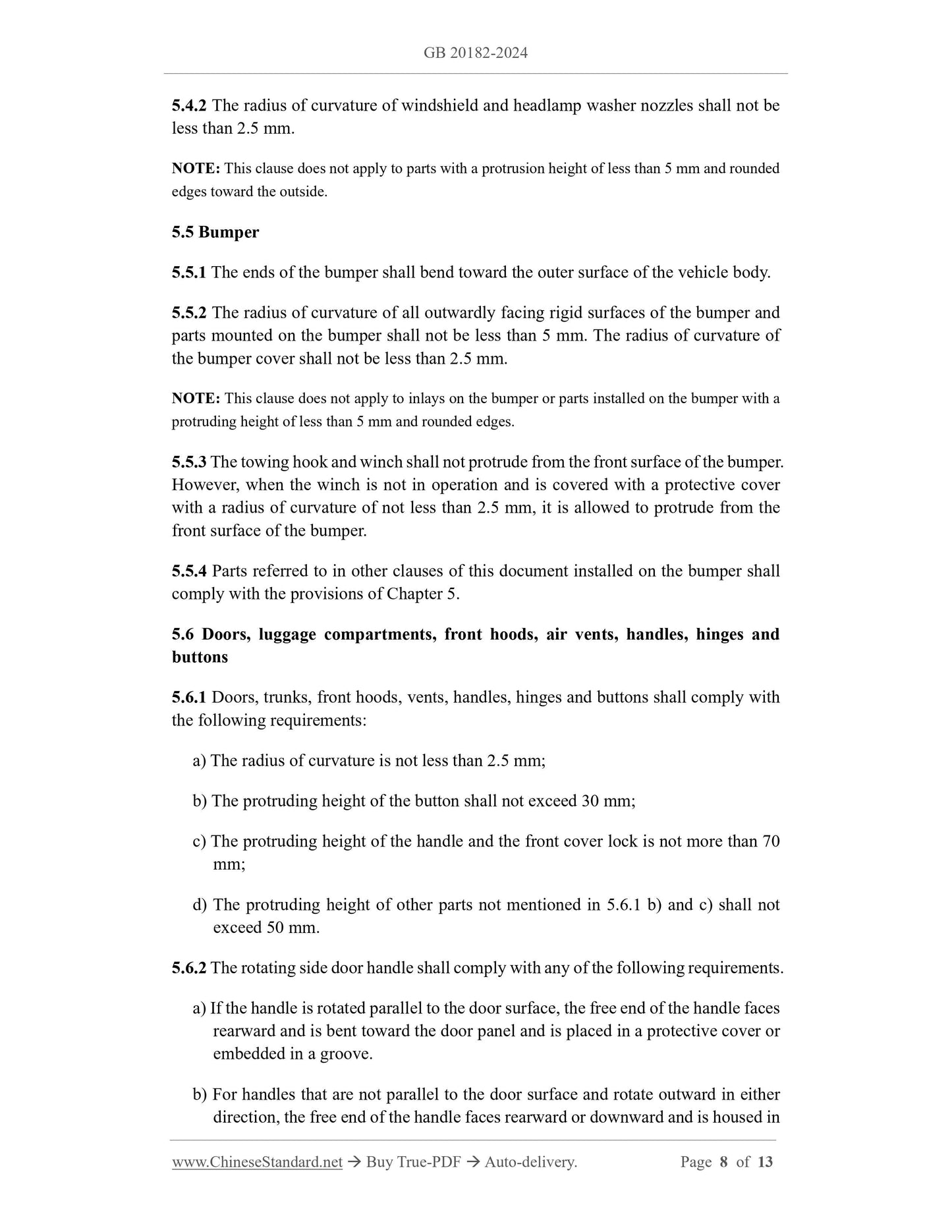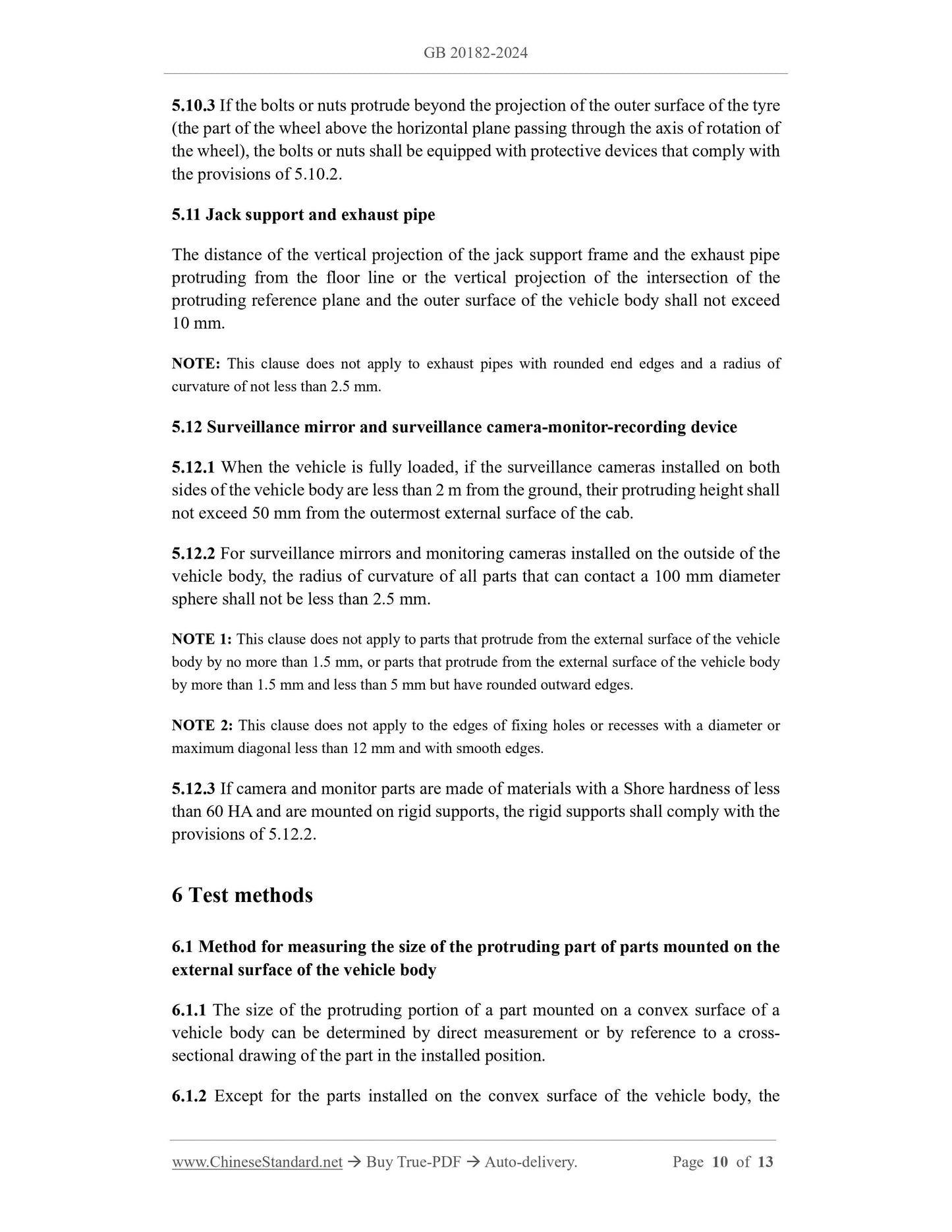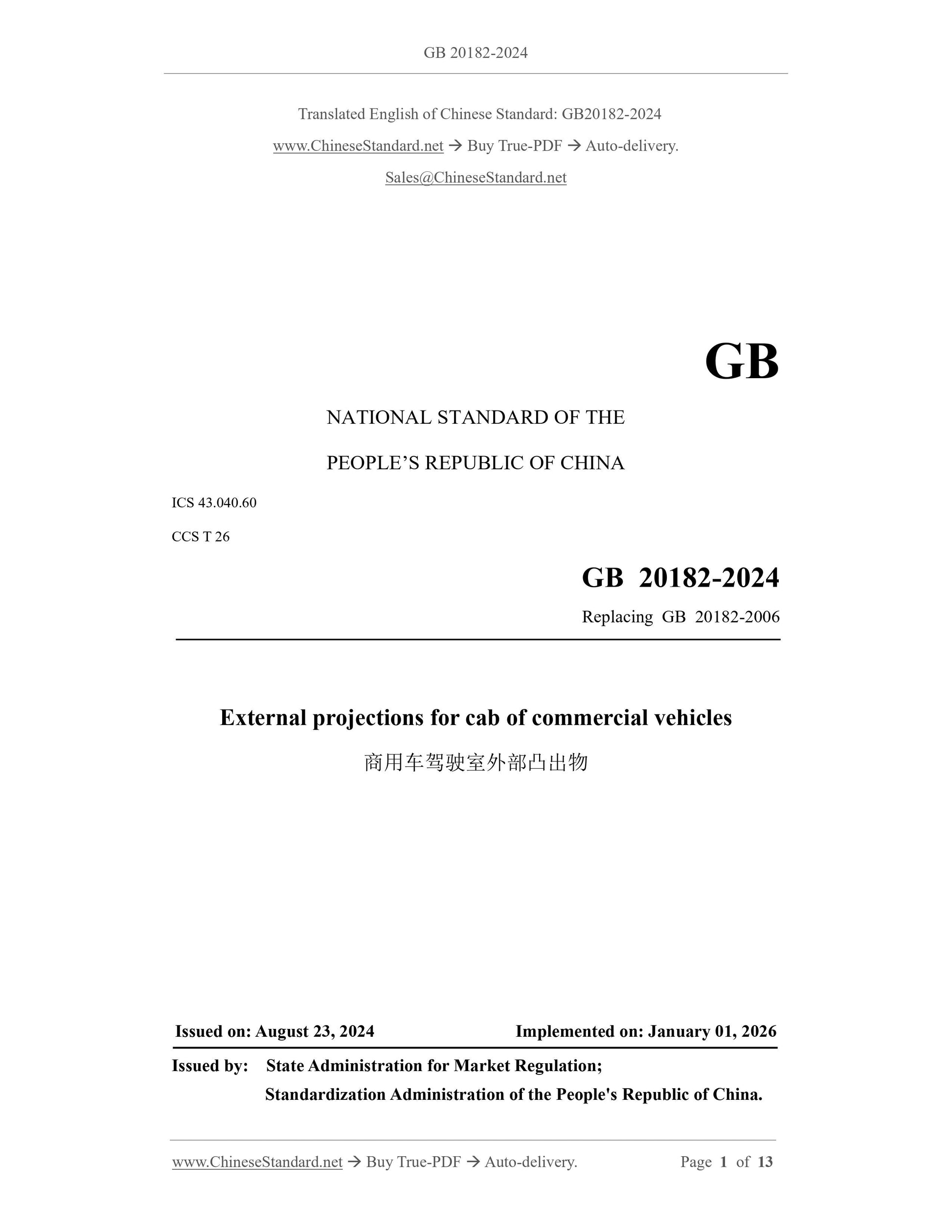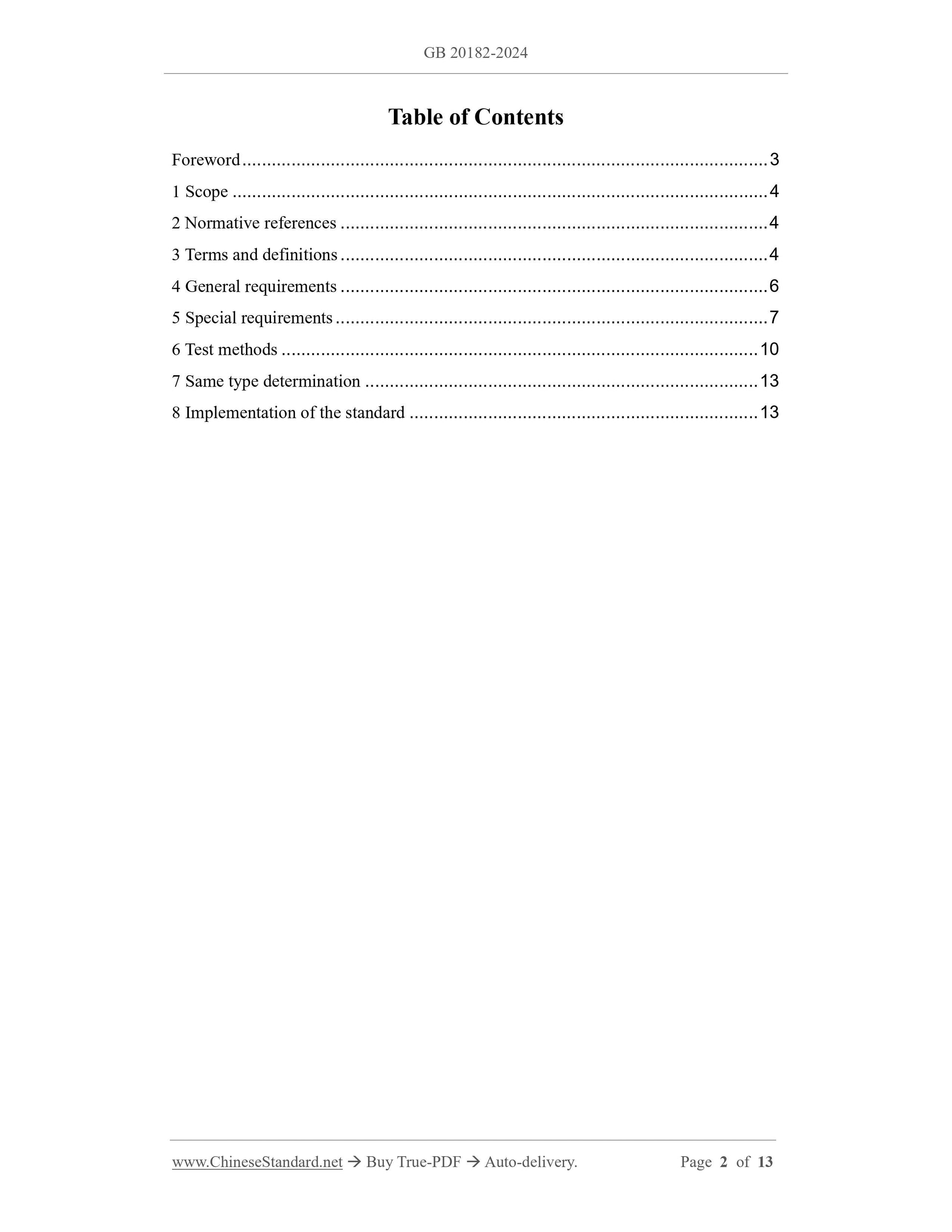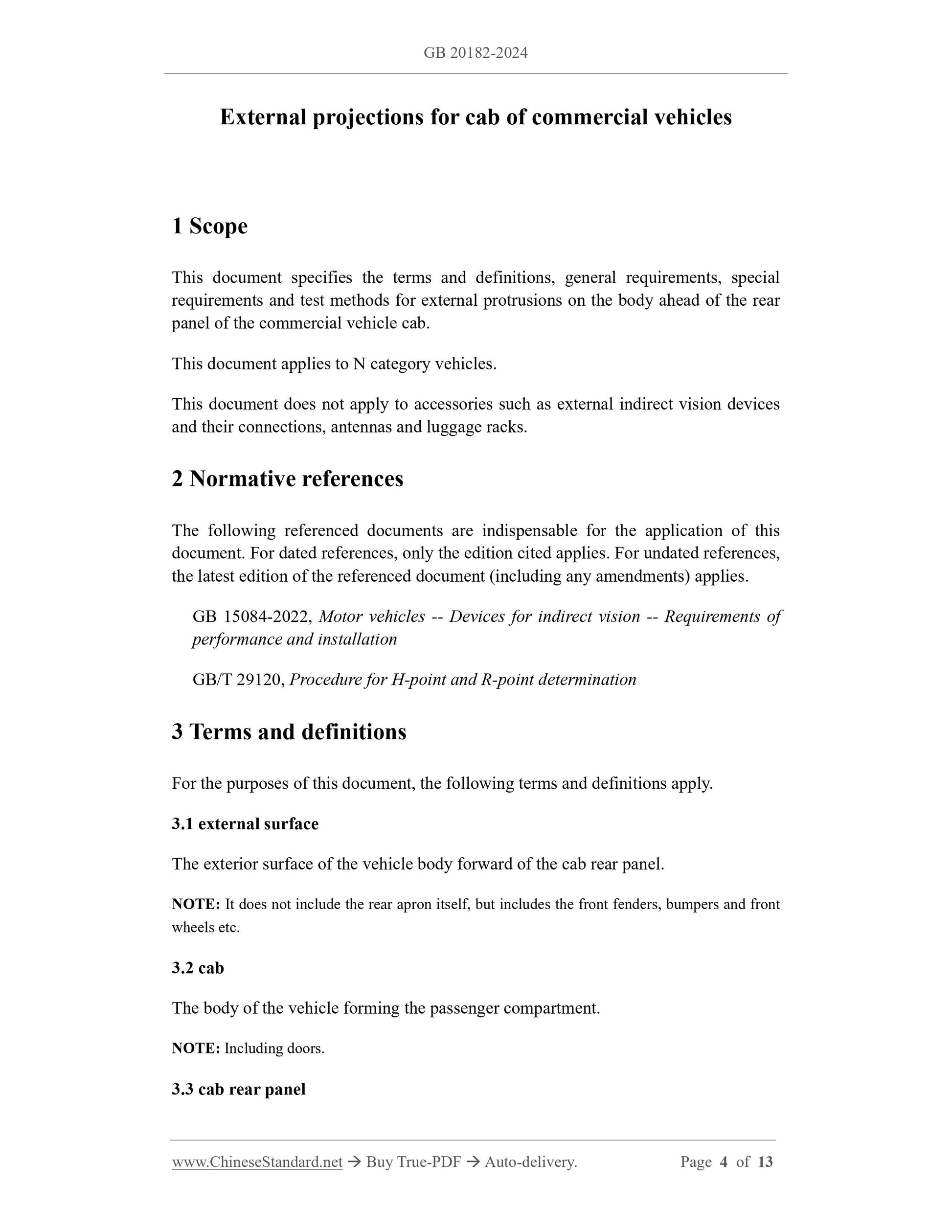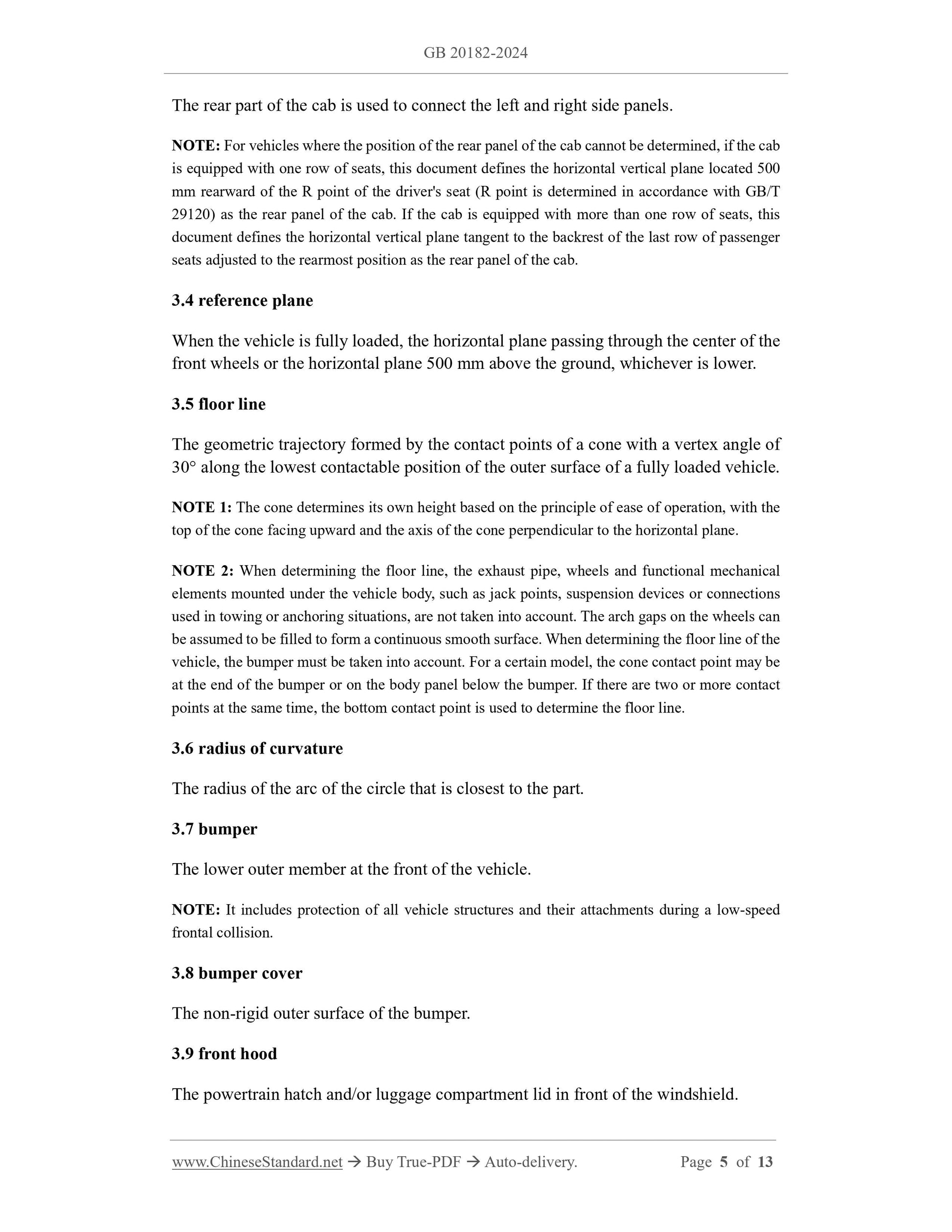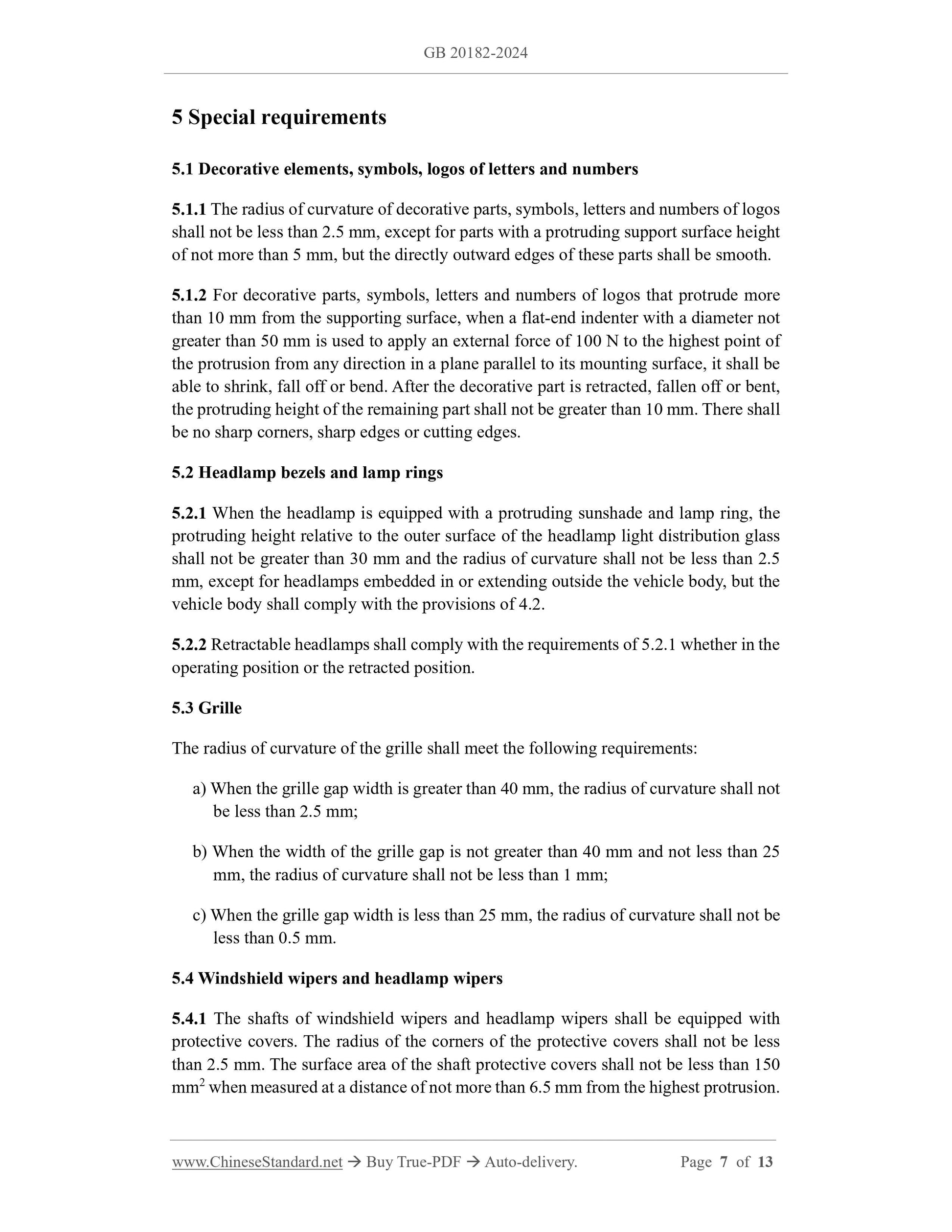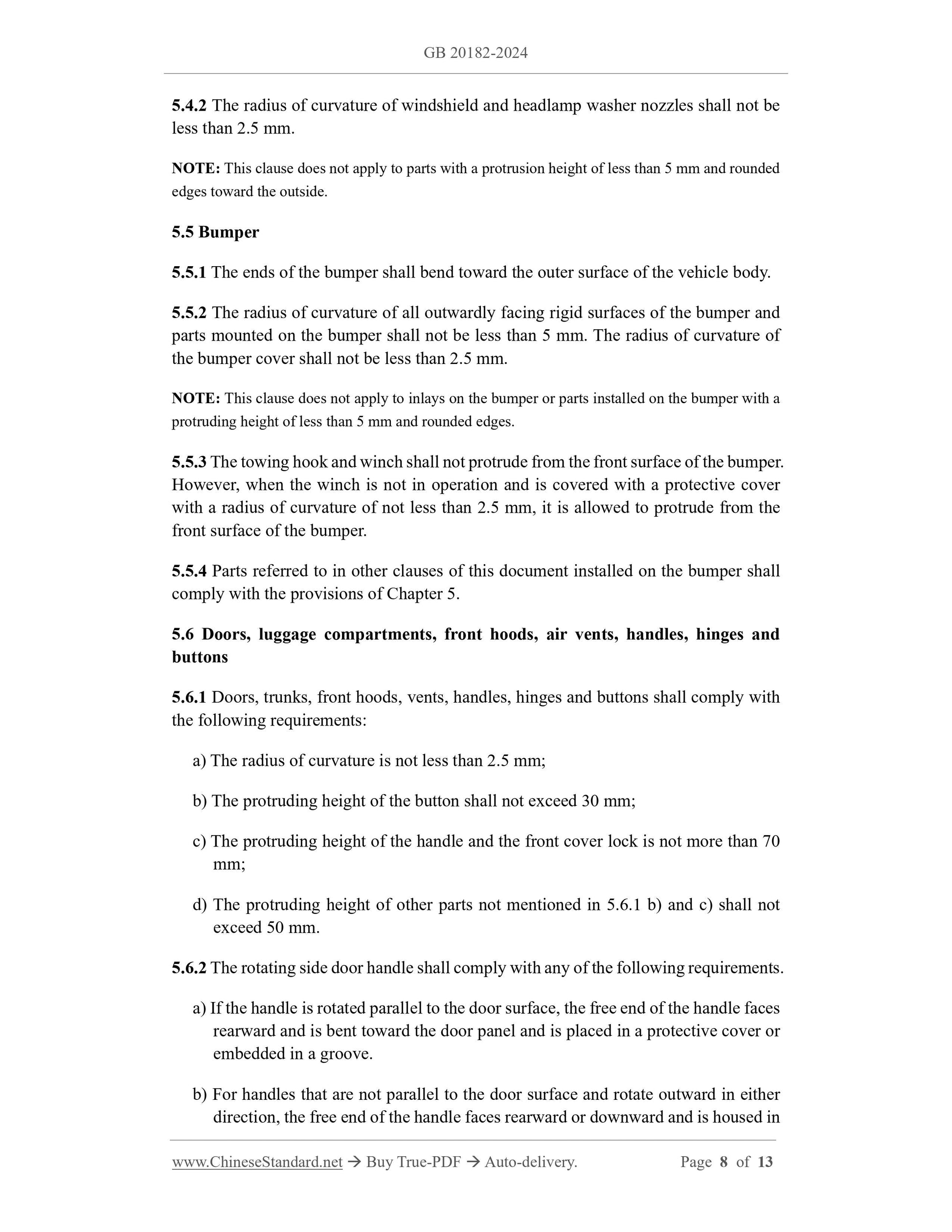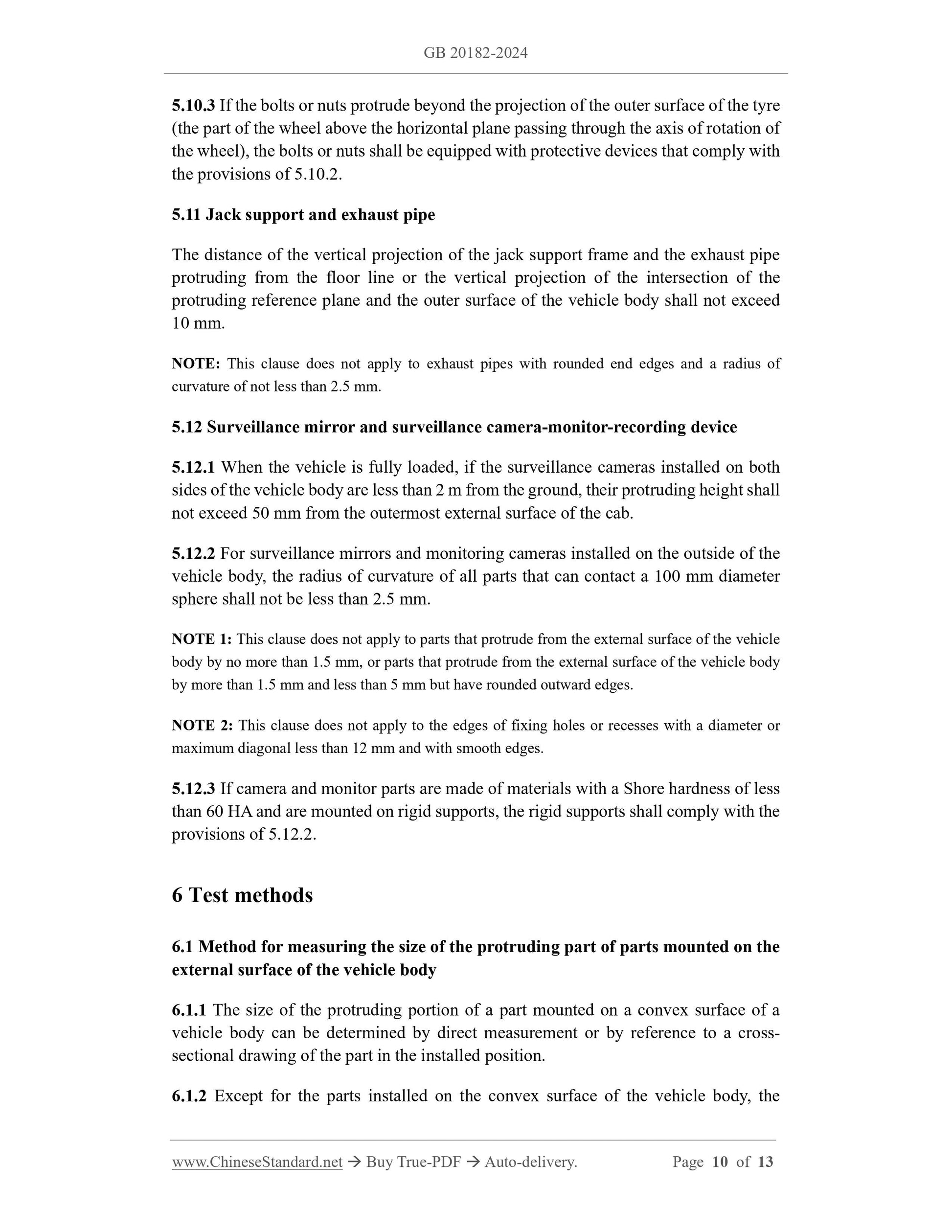1
/
of
7
PayPal, credit cards. Download editable-PDF and invoice in 1 second!
GB 20182-2024 English PDF (GB20182-2024)
GB 20182-2024 English PDF (GB20182-2024)
Regular price
$275.00 USD
Regular price
Sale price
$275.00 USD
Unit price
/
per
Shipping calculated at checkout.
Couldn't load pickup availability
Delivery: 3 seconds. Download true-PDF + Invoice.
Get QUOTATION in 1-minute: Click GB 20182-2024
Historical versions: GB 20182-2024
Preview True-PDF (Reload/Scroll if blank)
GB 20182-2024: External projections for cab of commerdial vehicles
GB 20182-2024
GB
NATIONAL STANDARD OF THE
PEOPLE’S REPUBLIC OF CHINA
ICS 43.040.60
CCS T 26
Replacing GB 20182-2006
External projections for cab of commercial vehicles
ISSUED ON: AUGUST 23, 2024
IMPLEMENTED ON: JANUARY 01, 2026
Issued by: State Administration for Market Regulation;
Standardization Administration of the People's Republic of China.
Table of Contents
Foreword ... 3
1 Scope ... 4
2 Normative references ... 4
3 Terms and definitions ... 4
4 General requirements ... 6
5 Special requirements ... 7
6 Test methods ... 10
7 Same type determination ... 13
8 Implementation of the standard ... 13
External projections for cab of commercial vehicles
1 Scope
This document specifies the terms and definitions, general requirements, special
requirements and test methods for external protrusions on the body ahead of the rear
panel of the commercial vehicle cab.
This document applies to N category vehicles.
This document does not apply to accessories such as external indirect vision devices
and their connections, antennas and luggage racks.
2 Normative references
The following referenced documents are indispensable for the application of this
document. For dated references, only the edition cited applies. For undated references,
the latest edition of the referenced document (including any amendments) applies.
GB 15084-2022, Motor vehicles -- Devices for indirect vision -- Requirements of
performance and installation
GB/T 29120, Procedure for H-point and R-point determination
3 Terms and definitions
For the purposes of this document, the following terms and definitions apply.
3.1 external surface
The exterior surface of the vehicle body forward of the cab rear panel.
NOTE: It does not include the rear apron itself, but includes the front fenders, bumpers and front
wheels etc.
3.2 cab
The body of the vehicle forming the passenger compartment.
NOTE: Including doors.
3.3 cab rear panel
The rear part of the cab is used to connect the left and right side panels.
NOTE: For vehicles where the position of the rear panel of the cab cannot be determined, if the cab
is equipped with one row of seats, this document defines the horizontal vertical plane located 500
mm rearward of the R point of the driver's seat (R point is determined in accordance with GB/T
29120) as the rear panel of the cab. If the cab is equipped with more than one row of seats, this
document defines the horizontal vertical plane tangent to the backrest of the last row of passenger
seats adjusted to the rearmost position as the rear panel of the cab.
3.4 reference plane
When the vehicle is fully loaded, the horizontal plane passing through the center of the
front wheels or the horizontal plane 500 mm above the ground, whichever is lower.
3.5 floor line
The geometric trajectory formed by the contact points of a cone with a vertex angle of
30° along the lowest contactable position of the outer surface of a fully loaded vehicle.
NOTE 1: The cone determines its own height based on the principle of ease of operation, with the
top of the cone facing upward and the axis of the cone perpendicular to the horizontal plane.
NOTE 2: When determining the floor line, the exhaust pipe, wheels and functional mechanical
elements mounted under the vehicle body, such as jack points, suspension devices or connections
used in towing or anchoring situations, are not taken into account. The arch gaps on the wheels can
be assumed to be filled to form a continuous smooth surface. When determining the floor line of the
vehicle, the bumper must be taken into account. For a certain model, the cone contact point may be
at the end of the bumper or on the body panel below the bumper. If there are two or more contact
points at the same time, the bottom contact point is used to determine the floor line.
3.6 radius of curvature
The radius of the arc of the circle that is closest to the part.
3.7 bumper
The lower outer member at the front of the vehicle.
NOTE: It includes protection of all vehicle structures and their attachments during a low-speed
frontal collision.
3.8 bumper cover
The non-rigid outer surface of the bumper.
3.9 front hood
The powertrain hatch and/or luggage compartment lid in front of the windshield.
5 Special requirements
5.1 Decorative elements, symbols, logos of letters and numbers
5.1.1 The radius of curvature of decorative parts, symbols, letters and numbers of logos
shall not be less than 2.5 mm, except for parts with a protruding support surface height
of not more than 5 mm, but the directly outward edges of these parts shall be smooth.
5.1.2 For decorative parts, symbols, letters and numbers of logos that protrude more
than 10 mm from the supporting surface, when a flat-end indenter with a diameter not
greater than 50 mm is used to apply an external force of 100 N to the highest point of
the protrusion from any direction in a plane parallel to its mounting surface, it shall be
able to shrink, fall off or bend. After the decorative part is retracted, fallen off or bent,
the protruding height of the remaining part shall not be greater than 10 mm. There shall
be no sharp corners, sharp edges or cutting edges.
5.2 Headlamp bezels and lamp rings
5.2.1 When the headlamp is equipped with a protruding sunshade and lamp ring, the
protruding height relative to the outer surface of the headlamp light distribution glass
shall not be greater than 30 mm and the radius of curvature shall not be less than 2.5
mm, except for headlamps embedded in or extending outside the vehicle body, but the
vehicle body shall comply with the provisions of 4.2.
5.2.2 Retractable headlamps shall comply with the requirements of 5.2.1 whether in the
operating position or the retracted position.
5.3 Grille
The radius of curvature of the grille shall meet the following requirements:
a) When the grille gap width is greater than 40 mm, the radius of curvature shall not
be less than 2.5 mm;
b) When the width of the grille gap is not greater than 40 mm and not less than 25
mm, the radius of curvature shall not be less than 1 mm;
c) When the grille gap width is less than 25 mm, the radius of curvature shall not be
less than 0.5 mm.
5.4 Windshield wipers and headlamp wipers
5.4.1 The shafts of windshield wipers and headlamp wipers shall be equipped with
protective covers. The radius of the corners of the protective covers shall not be less
than 2.5 mm. The surface area of the shaft protective covers shall not be less than 150
mm2 when measured at a distance of not more than 6.5 mm from the highest protrusion.
5.4.2 The radius of curvature of windshield and headlamp washer nozzles shall not be
less than 2.5 mm.
NOTE: This clause does not apply to parts with a protrusion height of less than 5 mm and rounded
edges toward the outside.
5.5 Bumper
5.5.1 The ends of the bumper shall bend toward the outer surface of the vehicle body.
5.5.2 The radius of curvature of all outwardly facing rigid surfaces of the bumper and
parts mounted on the bumper shall not be less than 5 mm. The radius of curvature of
the bumper cover shall not be less than 2.5 mm.
NOTE: This clause does not apply to inlays on the bumper or parts installed on the bumper with a
protruding height of less than 5 mm and rounded edges.
5.5.3 The towing hook and winch shall not protrude from the front surface of the bumper.
However, when the winch is not in operation and is covered wit...
Get QUOTATION in 1-minute: Click GB 20182-2024
Historical versions: GB 20182-2024
Preview True-PDF (Reload/Scroll if blank)
GB 20182-2024: External projections for cab of commerdial vehicles
GB 20182-2024
GB
NATIONAL STANDARD OF THE
PEOPLE’S REPUBLIC OF CHINA
ICS 43.040.60
CCS T 26
Replacing GB 20182-2006
External projections for cab of commercial vehicles
ISSUED ON: AUGUST 23, 2024
IMPLEMENTED ON: JANUARY 01, 2026
Issued by: State Administration for Market Regulation;
Standardization Administration of the People's Republic of China.
Table of Contents
Foreword ... 3
1 Scope ... 4
2 Normative references ... 4
3 Terms and definitions ... 4
4 General requirements ... 6
5 Special requirements ... 7
6 Test methods ... 10
7 Same type determination ... 13
8 Implementation of the standard ... 13
External projections for cab of commercial vehicles
1 Scope
This document specifies the terms and definitions, general requirements, special
requirements and test methods for external protrusions on the body ahead of the rear
panel of the commercial vehicle cab.
This document applies to N category vehicles.
This document does not apply to accessories such as external indirect vision devices
and their connections, antennas and luggage racks.
2 Normative references
The following referenced documents are indispensable for the application of this
document. For dated references, only the edition cited applies. For undated references,
the latest edition of the referenced document (including any amendments) applies.
GB 15084-2022, Motor vehicles -- Devices for indirect vision -- Requirements of
performance and installation
GB/T 29120, Procedure for H-point and R-point determination
3 Terms and definitions
For the purposes of this document, the following terms and definitions apply.
3.1 external surface
The exterior surface of the vehicle body forward of the cab rear panel.
NOTE: It does not include the rear apron itself, but includes the front fenders, bumpers and front
wheels etc.
3.2 cab
The body of the vehicle forming the passenger compartment.
NOTE: Including doors.
3.3 cab rear panel
The rear part of the cab is used to connect the left and right side panels.
NOTE: For vehicles where the position of the rear panel of the cab cannot be determined, if the cab
is equipped with one row of seats, this document defines the horizontal vertical plane located 500
mm rearward of the R point of the driver's seat (R point is determined in accordance with GB/T
29120) as the rear panel of the cab. If the cab is equipped with more than one row of seats, this
document defines the horizontal vertical plane tangent to the backrest of the last row of passenger
seats adjusted to the rearmost position as the rear panel of the cab.
3.4 reference plane
When the vehicle is fully loaded, the horizontal plane passing through the center of the
front wheels or the horizontal plane 500 mm above the ground, whichever is lower.
3.5 floor line
The geometric trajectory formed by the contact points of a cone with a vertex angle of
30° along the lowest contactable position of the outer surface of a fully loaded vehicle.
NOTE 1: The cone determines its own height based on the principle of ease of operation, with the
top of the cone facing upward and the axis of the cone perpendicular to the horizontal plane.
NOTE 2: When determining the floor line, the exhaust pipe, wheels and functional mechanical
elements mounted under the vehicle body, such as jack points, suspension devices or connections
used in towing or anchoring situations, are not taken into account. The arch gaps on the wheels can
be assumed to be filled to form a continuous smooth surface. When determining the floor line of the
vehicle, the bumper must be taken into account. For a certain model, the cone contact point may be
at the end of the bumper or on the body panel below the bumper. If there are two or more contact
points at the same time, the bottom contact point is used to determine the floor line.
3.6 radius of curvature
The radius of the arc of the circle that is closest to the part.
3.7 bumper
The lower outer member at the front of the vehicle.
NOTE: It includes protection of all vehicle structures and their attachments during a low-speed
frontal collision.
3.8 bumper cover
The non-rigid outer surface of the bumper.
3.9 front hood
The powertrain hatch and/or luggage compartment lid in front of the windshield.
5 Special requirements
5.1 Decorative elements, symbols, logos of letters and numbers
5.1.1 The radius of curvature of decorative parts, symbols, letters and numbers of logos
shall not be less than 2.5 mm, except for parts with a protruding support surface height
of not more than 5 mm, but the directly outward edges of these parts shall be smooth.
5.1.2 For decorative parts, symbols, letters and numbers of logos that protrude more
than 10 mm from the supporting surface, when a flat-end indenter with a diameter not
greater than 50 mm is used to apply an external force of 100 N to the highest point of
the protrusion from any direction in a plane parallel to its mounting surface, it shall be
able to shrink, fall off or bend. After the decorative part is retracted, fallen off or bent,
the protruding height of the remaining part shall not be greater than 10 mm. There shall
be no sharp corners, sharp edges or cutting edges.
5.2 Headlamp bezels and lamp rings
5.2.1 When the headlamp is equipped with a protruding sunshade and lamp ring, the
protruding height relative to the outer surface of the headlamp light distribution glass
shall not be greater than 30 mm and the radius of curvature shall not be less than 2.5
mm, except for headlamps embedded in or extending outside the vehicle body, but the
vehicle body shall comply with the provisions of 4.2.
5.2.2 Retractable headlamps shall comply with the requirements of 5.2.1 whether in the
operating position or the retracted position.
5.3 Grille
The radius of curvature of the grille shall meet the following requirements:
a) When the grille gap width is greater than 40 mm, the radius of curvature shall not
be less than 2.5 mm;
b) When the width of the grille gap is not greater than 40 mm and not less than 25
mm, the radius of curvature shall not be less than 1 mm;
c) When the grille gap width is less than 25 mm, the radius of curvature shall not be
less than 0.5 mm.
5.4 Windshield wipers and headlamp wipers
5.4.1 The shafts of windshield wipers and headlamp wipers shall be equipped with
protective covers. The radius of the corners of the protective covers shall not be less
than 2.5 mm. The surface area of the shaft protective covers shall not be less than 150
mm2 when measured at a distance of not more than 6.5 mm from the highest protrusion.
5.4.2 The radius of curvature of windshield and headlamp washer nozzles shall not be
less than 2.5 mm.
NOTE: This clause does not apply to parts with a protrusion height of less than 5 mm and rounded
edges toward the outside.
5.5 Bumper
5.5.1 The ends of the bumper shall bend toward the outer surface of the vehicle body.
5.5.2 The radius of curvature of all outwardly facing rigid surfaces of the bumper and
parts mounted on the bumper shall not be less than 5 mm. The radius of curvature of
the bumper cover shall not be less than 2.5 mm.
NOTE: This clause does not apply to inlays on the bumper or parts installed on the bumper with a
protruding height of less than 5 mm and rounded edges.
5.5.3 The towing hook and winch shall not protrude from the front surface of the bumper.
However, when the winch is not in operation and is covered wit...
Share
